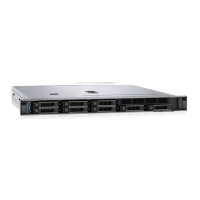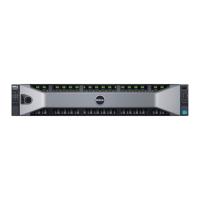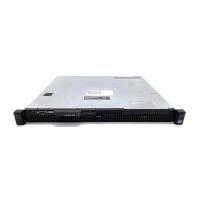Table 46. System Security details
Option Description
CPU AES-NI Improves the speed of applications by performing encryption and decryption by using
the Advanced Encryption Standard Instruction Set (AES-NI). This option is set to
Enabled by default.
System Password Sets the system password. This option is set to Enabled by default and is read-only if
the password jumper is not installed in the system.
Setup Password Sets the setup password. This option is read-only if the password jumper is not installed
in the system.
Password Status Locks the system password. This option is set to Unlocked by default.
TPM Information Indicates the type of Trusted Platform Module, if present.
Table 47. TPM 2.0 security information
Option Description
TPM Information
TPM
Security
NOTE: The TPM menu is available only when the TPM module is installed.
Enables you to control the reporting mode of the TPM. When set to Off, the presence of the TPM is not
reported to the OS. When set to On, the presence of the TPM is reported to the OS. The TPM Security option
is set to Off by default.
When TPM 2.0 is installed, the TPM Security option is set to On or Off. This option is set to Off by default.
TPM
Informatio
n
Indicates the type of Trusted Platform Module, if present.
TPM
Firmware
Indicates the firmware version of the TPM.
TPM
Hierarcy
Enables, disables, or clears the storage and endorsement hierarchies. When set to Enabled, the storage and
endorsement hierarchies can be used.
When set to Disabled, the storage and endorsement hierarchies cannot be used.
When set to Clear, the storage and endorsement hierarchies are cleared of any values, and then reset to
Enabled.
TPM
Advanced
Settings
TPM PPI
Bypass
Provision
When set to Enabled, allows the Operating System to bypass Physical Presence Interface
(PPI) prompts when issuing PPI Advanced Configuration and Power interface (ACPI)
provisioning operations.
TPM PPI
Bypass Clear
When set to Enabled allows the Operating System to bypass Physical Presence Interface
(PPI) prompts when issuing PPI Advanced Configuration and Power Interface (ACPI) clear
operations.
TPM2
Algorithm
Selection
Allows the user to change the cryptographic algorithms used in the Trusted Platform Module
(TPM). The available options are dependent on the TPM firmware.
To enable TPM2 Algorithm Selection, Intel(R) TXT technology must be disabled.
The TPM2 Algorithm Selection option supports SHA1, SHA128, SHA256, SHA512 and SM3 by
detecting the TPM module. This option is set to
SHA1 by default.
Table 48. System Security details
Option Description
Power button: Enables or disables the power button on the front of the system. This option is set to
Enabled by default.
40 Pre-operating system management applications

